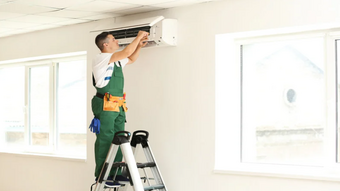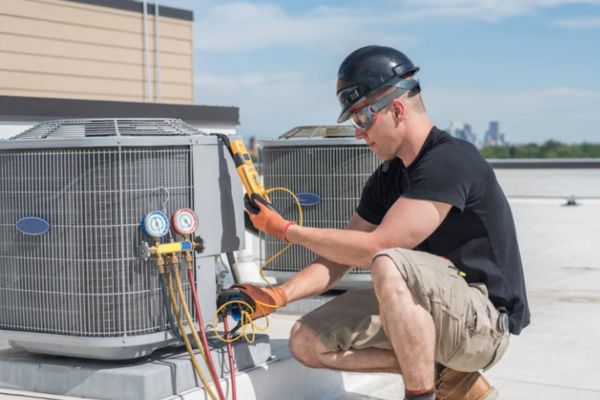Choosing the best HVAC system for your home can feel like a big decision, but it’s all about finding what works best for your space, comfort, and budget. Whether you’re looking to stay cool in the summer or warm in the winter, the right system can make a huge difference in how your home feels and how much you pay for energy. Let’s break it down so you can figure out which HVAC system is the best fit for you.

Split System
A split system is a popular HVAC setup with parts inside and outside your home. It combines a furnace for heating and an air conditioner for cooling, making it a good choice for most climates.
Pros:
- Energy efficient
- Can be retrofitted to work with existing furnaces
Cons:
- Higher upfront costs (installation can range from $3,000 to $7,500)
- Requires both indoor and outdoor work during installation
Split systems are a great investment for homes with existing ductwork, especially if you need heating and cooling all year round.
Hybrid Heat Split System
Hybrid heat split systems combine a furnace with an electric heat pump. This allows the system to use electricity for heating in mild weather and gas for colder temperatures, helping save energy depending on the weather.
Pros:
- Energy-efficient year-round
- Suitable for temperate regions
Cons:
- It can be more expensive to operate during extreme cold
- Installation costs can range from $4,000 to $8,000
Hybrid systems are a great option for reducing heating costs in regions with mild winters but still offer powerful heating for colder days.
Duct-Free Split System
Duct-free systems, called mini-splits, don’t need ducts, so they’re perfect for homes without them or specific rooms and additions. These systems use heat pumps, are energy-efficient, and provide clean air.
Pros:
- High energy efficiency (can save up to 30% on energy bills)
- Improves air quality by reducing allergens
- It is safer as it doesn’t use combustion or release carbon monoxide
Cons:
- Not ideal for cold climates
- Requires regular maintenance (installation costs range from $2,000 to $5,000 per unit)
Duct-free systems are perfect for homes without ducts or targeting specific areas like garages, sunrooms, or additions.
Packaged System
Packaged systems are small units where all the heating and cooling parts are kept outside. They’re perfect for homes that don’t have a lot of indoor space and give you heating and cooling in one system.
Pros:
- Space-saving
- Less expensive than split systems (typically $4,000 to $8,000)
Cons:
- Less efficient than split systems
Packaged systems are a practical solution for smaller homes or homes without the space for separate indoor and outdoor units.
Energy Efficiency in HVAC Systems
Energy efficiency is a critical factor in long-term savings on your HVAC system. The more efficient your system, the lower your energy bills will be. When evaluating systems, consider both heating and cooling efficiency metrics:
- Cooling Efficiency: It is measured by SEER (Seasonal Energy Efficiency Ratio). The federal minimum is 13 or 14, but systems with higher SEER ratings (16 and above) will offer better energy savings. High-efficiency systems can reduce cooling costs by up to 20%.
- Heating Efficiency: It is measured by AFUE (Annual Fuel Utilization Efficiency). A higher AFUE rating means the system uses less fuel to generate heat. The federal minimum is 78%, but systems with ratings in the 90s are the most efficient, translating to lower heating bills.
Hiring an HVAC Contractor
Once you’ve selected a system, hiring a qualified HVAC contractor is essential for proper installation. Poor installation can lead to inefficient performance, higher energy costs, and even safety issues. When searching for a contractor, look for the following:
- Licensing and Certification: Ensure the contractor is licensed in your area and holds additional certifications, such as North American Technician Excellence (NATE) or Indoor Environment and Energy Efficiency Association (IE3) membership.
- Cost of Installation: Labor costs for HVAC installation typically range from $1,500 to $3,000, depending on the complexity of the job and your location.
Investing in a qualified professional can make a significant difference in the longevity and performance of your HVAC system.
Alternative Heating and Cooling Systems
Besides regular HVAC systems, there are other heating and cooling options that can help save energy and lower costs. These alternative systems are becoming more popular, especially in certain climates or for people who want to be more environmentally friendly.
Evaporative Coolers
Evaporative coolers are best suited for dry climates and use water to cool the air, making them a greener option than traditional AC units.
Pros:
- Environmentally friendly
- Lower energy consumption (typically uses about 50% less energy than central AC)
Cons:
- Ineffective in humid areas
- Costs between $1,500 and $3,500 installed
These systems are great for desert or dry areas with low humidity, where regular air conditioning doesn’t work as well.
Radiant Heating
Radiant heating systems are installed beneath the flooring and offer an efficient way to heat rooms. Since heat naturally rises, this method works better than regular heating systems.
Pros:
- Highly efficient
- Provides consistent, even heating
Cons:
- Expensive to install (typically $10,000 to $25,000 for a full home installation)
- Difficult to retrofit in existing homes
Radiant heating is a great option if you’re building a new home or doing a big renovation, but it’s not as easy to install in an existing home.
Solar Space Heaters
Solar space heaters are an affordable and environmentally friendly way to heat small areas. These systems use the sun’s energy to provide supplemental heating.
Pros:
- Cost-effective, especially in sunny climates
- It can be paired with other heating methods for maximum efficiency
Cons:
- Limited effectiveness in cloudy or cold areas
- Typically costs between $500 and $1,500
Solar space heaters are an excellent option for homeowners looking to offset heating costs, especially in regions with ample sunlight.
Conclusion
When choosing an HVAC system, it’s important to balance upfront costs with long-term savings. Energy-efficient systems might cost more at first, but they help lower your energy bills and make your home more comfortable over time. Also, make sure the system is the right size for your home to avoid wasting energy and causing damage to the system.
Replacing or upgrading your HVAC system is a significant investment, but it will impact your home’s comfort and energy use for years. By understanding your options and carefully considering your needs, you can select a system that keeps your home comfortable while saving you money in the long run.


